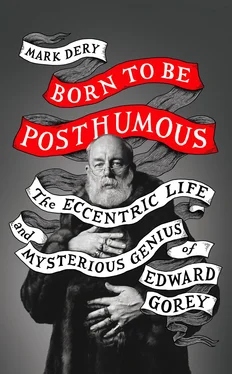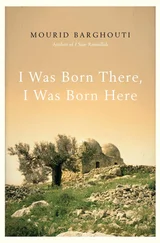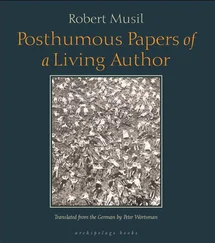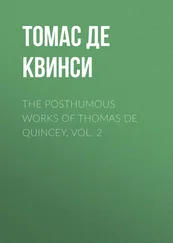Army life, Gorey wrote to his friend and former Parker schoolmate Bea Rosen, was dull to the point of deadliness. 84At one point, he and his company were marched out into the wastelands around Camp Roberts and bivouacked there, God knows why, a state of affairs Gorey found “too, too feeble-making.” 85He and his fellow grunts were sleeping on brick-hard ground, he told Rosen, and subsisting on canned rations eaten cold. Dessert consisted of chocolate bars that tasted suspiciously like Ex-Lax and had “practically the same effect, if not more so.” His mood was not improved when he managed to drop a rifle on his foot. The army routine alternated between torment and tedium; that, along with the infernal heat and lunar desolation of the place, was driving him out of his gourd, he claimed.
Gorey’s voice on the page is something to hear, as far from the average GI writing home as Oscar Wilde’s arch quips are from Hemingway’s tough-guy bluster. He opens his letters to Rosen with stage-entrance salutations like “Darling,” closes them with high-flown effusions (“tidal waves of passion” is a typical sign-off), and adopts pet names (he’s “Theo”; Rosen is “Beatrix the light of my life”). He affects a knowingness, a world-weariness; he indulges in high-opera histrionics and flights of fancy. It’s the put-on persona of a teenage aesthete who has lived much of his young life between the covers of a book. Life, he insists, is a tear-sodden handkerchief, a crumpled straw in a soda glass sucked dry, a foot-draggingly gloomy procession of “frustrated desires” and “sex entanglements from what they tell me—I wouldn’t know … ” 86(Interesting to note that at eighteen—an age when most young men are feeling their oats—he’s already holding the subject of “sex entanglements” at arm’s length.)
Gorey’s letters are a study in camp. His tone is equal parts Sebastian Flyte, the charmingly unworldly idler from Brideshead Revisited , and the impulsive, outspoken Holly Golightly from Breakfast at Tiffany’s , down to Holly’s precious use of French to signal her cosmopolitan chic. In a letter to Rosen, Gorey sighs, “The ancient esprit d’aventure still lives but what can it do?” 87
Gorey’s summer in “God’s garbage pit,” as he called it, wasn’t all cold canned rations and damp rot of the soul. Rummaging through the camp library in his never-ending search for something new to read, he happened on E. F. Benson’s Mapp and Lucia novels. “I first discovered them during World War II—quite by accident, although I prefer to think of it as Fate—in the library of Camp Roberts, California, where I took my basic training in the summer of 1943,” he remembered in “I Love Lucia,” an appreciation he wrote for the May 1986 issue of Vogue . 88
Fate indeed: Benson’s comedies of manners arrived at just the right moment to influence Gorey’s emerging persona, that of an arch, Anglophilic aesthete. Wickedly witty and unimprovably English in their attention to small-town gossip and social jockeying, the Mapp and Lucia novels delight in the snobbery and pretensions of two smilingly vicious doyennes who elevate social climbing to a blood sport. As it happens, Benson (1867–1940) was gay, and the Mapp and Lucia novels are “cult classics … among gay readers,” according to the literary critic David Leon Higdon, beloved for “their campy exaggerations, social jealousies, and gentle but not altogether affectionate social satire.” 89Was Gorey drawn to Benson’s novels because he recognized in Benson’s voice a kindred style of mind, a covert consciousness that wore its wit as an invisibility cloak?
Whatever the reason, the books made a lasting impression on him: when asked about his favorite authors, he often mentioned Benson. “If I were driven to decide what to take along to a desert island,” he said in 1978, “it would be a toss-up among Jane Austen’s complete works, [the eleventh-century Japanese novel] The Tale of Genji , the ‘Lucia’ books, or one of the Trollope series,” adding, “I’ve read the ‘Lucia’ books so often I almost know them by heart.” 90
Four months after his arrival at Camp Roberts, Gorey completed his basic training, in the course of which he, the overwrought aesthete, last seen dropping his rifle on his foot, managed to earn expert badges in pistol and rifle marksmanship.
Then the army had new marching orders for Private Gorey: he was to enroll in college under the auspices of the Army Specialized Training Program (ASTP). “Note well the utterly hysterical fact that the Army is sending me to college to study languages under ASTP,” he wrote Rosen. 91Launched in 1943, the ASTP was intended “to provide the continuous and accelerated flow of high grade technicians and specialists needed by the Army.” 92Soldiers who scored high on military IQ tests were sent to select universities—in uniform, on active duty, and still subject to military discipline—for fast-tracked courses in engineering, medicine, and any of thirty-four foreign languages. Gorey was assigned to study Japanese, perhaps in advance of the anticipated occupation of Japan, where US administrators would be needed.
He entered the University of Chicago in the winter quarter of 1943. On November 8, he began courses. Two days later, he was diagnosed with scarlet fever and hospitalized for six weeks. Back on his feet, he reentered the program and was transferred, on February 7, 1944, to something called Curriculum 71, which entailed studying conversational Japanese along with contemporary history and geography. Then, on March 22, the army, with its usual sagacity, shut down the program in mid-term, around five weeks before it would have ended. By Gorey’s tally, he’d had “only two months” of study. 93
In June, or thereabouts, the army, again demonstrating the discernment for which it is universally admired, put PFC Gorey’s record-breaking IQ to good use: he was dispatched to Dugway Proving Ground, an army base in the Great Salt Lake Desert, to sit out the rest of the war as a company clerk.
*After Skeezix, the foundling left on a doorstep in the long-running newspaper strip Gasoline Alley .
*According to Elizabeth M. Tamny in an unedited early draft of her November 10, 2005, Chicago Reader feature, “What’s Gorey’s Story? The Formative Years of a Very Peculiar Man,” Gorey was awarded scholarships to the University of Chicago and Carnegie Mellon as well. Reportedly his was the highest score in the Midwest the year he took the college boards. Tamny cites her phone interview with Andreas Brown as the source of these details.
CHAPTER 2 CHAPTER 2: Mauve Sunsets: Dugway, 1944–46 CHAPTER 3: “Terribly Intellectual and Avant-Garde and All That Jazz”: Harvard, 1946–50 CHAPTER 4: Sacred Monsters: Cambridge, 1950–53 CHAPTER 5: “Like a Captive Balloon, Motionless Between Sky and Earth”: New York, 1953 CHAPTER 6: Hobbies Odd—Ballet, the Gotham Book Mart, Silent Film, Feuillade: 1953 CHAPTER 7: Épater le Bourgeois: 1954–58 CHAPTER 8: “Working Perversely to Please Himself”: 1959–63 CHAPTER 9: Nursery Crimes— The Gashlycrumb Tinies and Other Outrages: 1963 CHAPTER 10: Worshipping in Balanchine’s Temple: 1964–67 CHAPTER 11: Mail Bonding—Collaborations: 1967–72 CHAPTER 12: Dracula: 1973–78 CHAPTER 13: Mystery!: 1979–85 CHAPTER 14: Strawberry Lane Forever: Cape Cod, 1985–2000 CHAPTER 15: Flapping Ankles, Crazed Teacups, and Other Entertainments CHAPTER 16: “Awake in the Dark of Night Thinking Gorey Thoughts” CHAPTER 17: The Curtain Falls Notes A Note on Sources A Gorey Bibliography Index Acknowledgments About the Author Also by Mark Dery About the Publisher
MAUVE SUNSETS CHAPTER 2: Mauve Sunsets: Dugway, 1944–46 CHAPTER 3: “Terribly Intellectual and Avant-Garde and All That Jazz”: Harvard, 1946–50 CHAPTER 4: Sacred Monsters: Cambridge, 1950–53 CHAPTER 5: “Like a Captive Balloon, Motionless Between Sky and Earth”: New York, 1953 CHAPTER 6: Hobbies Odd—Ballet, the Gotham Book Mart, Silent Film, Feuillade: 1953 CHAPTER 7: Épater le Bourgeois: 1954–58 CHAPTER 8: “Working Perversely to Please Himself”: 1959–63 CHAPTER 9: Nursery Crimes— The Gashlycrumb Tinies and Other Outrages: 1963 CHAPTER 10: Worshipping in Balanchine’s Temple: 1964–67 CHAPTER 11: Mail Bonding—Collaborations: 1967–72 CHAPTER 12: Dracula: 1973–78 CHAPTER 13: Mystery!: 1979–85 CHAPTER 14: Strawberry Lane Forever: Cape Cod, 1985–2000 CHAPTER 15: Flapping Ankles, Crazed Teacups, and Other Entertainments CHAPTER 16: “Awake in the Dark of Night Thinking Gorey Thoughts” CHAPTER 17: The Curtain Falls Notes A Note on Sources A Gorey Bibliography Index Acknowledgments About the Author Also by Mark Dery About the Publisher
Читать дальше












